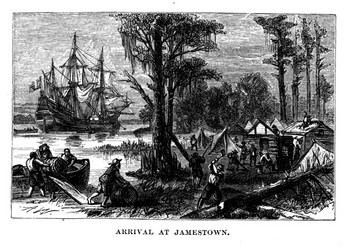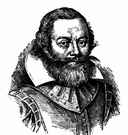The Making of the 50 States: Virginia
Part 1: In the Beginning Virginia was the 10th state to ratify the Constitution. As with other of the 13 Colonies, the land was originally inhabited by Native Americans. The main tribes living in the area were the Powhatan. Other tribes included the Cherokee, Chickahominy, Chesapeake, Nottoway, Pocomoke, and Shawnee. These Native Americans hunted deer and bear and caught fish and shellfish. They grew beans, corn, pumpkins, and squash. They lived in round or rectangular homes made of wood, bark, long grasses, or animal skins.
This settlement was named for the English king at the time, James I. It had a strong leader in John Smith, who almost singlehandedly kept the colony going for two years. During that time, he established peaceful The next year, a new leader arrived. This was Sir Thomas West, Lord De la Warr. He was the first governor of the colony and had the full backing of the English crown to take absolute control of the running of the colony. He was moderately successful for a number of years, helping the people survive through very hard times, including the failure of glassmaking and shipbuilding businesses. In 1622, a Native American attack significantly reduced the settler population, as did a wave of the plague later on. The colony survived, however, and settlements spread. One thing that happened during those lean years after John Smith's departure was the introduction of tobacco harvesting, by John Rolfe. (This was the same John Rolfe who married Pocahontas, daughter of Powhatan.) The settlers planted Orinoco and Sweet Scented seeds and exported their first crop in 1614.
Next page > The Rest of the Story > Page 1, 2 |
|
Social Studies for Kids
copyright 2002–2024
David White



 The first Europeans to settle in what we now know as Virginia were from England. After several attempts at settlement by Humphrey Gilbert and
The first Europeans to settle in what we now know as Virginia were from England. After several attempts at settlement by Humphrey Gilbert and  relations with the nearby Native Americans, resulting in food and security; explored the surrounding countryside, looking for new places for settlement; and even drew a map of what he saw (which historians now regard as exceedingly accurate). In 1609, however, Smith returned to England. The settlers suffered while he was gone. They later called this period the "starving time." The winter was especially harsh, and Smith was not around to appease the suddenly unfriendly Native Americans. Without such a strong leader, also, the people descended into in-fighting.
relations with the nearby Native Americans, resulting in food and security; explored the surrounding countryside, looking for new places for settlement; and even drew a map of what he saw (which historians now regard as exceedingly accurate). In 1609, however, Smith returned to England. The settlers suffered while he was gone. They later called this period the "starving time." The winter was especially harsh, and Smith was not around to appease the suddenly unfriendly Native Americans. Without such a strong leader, also, the people descended into in-fighting. The people also took a major step toward representative government with the formation of the
The people also took a major step toward representative government with the formation of the 
